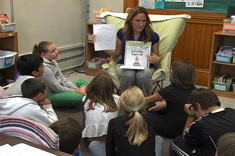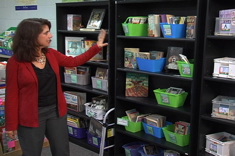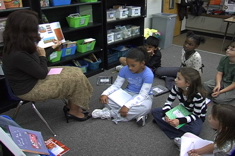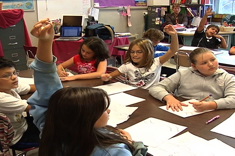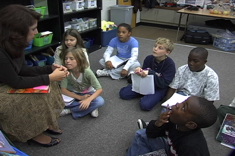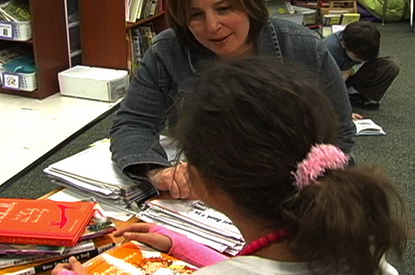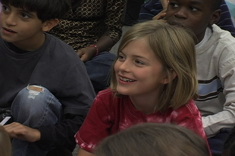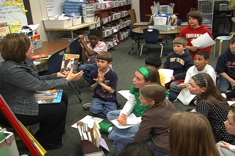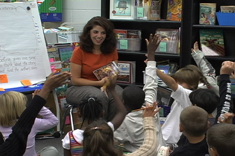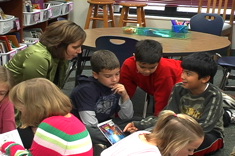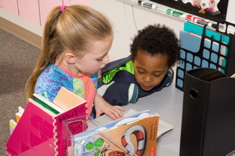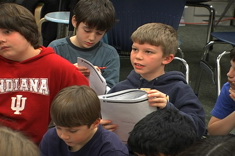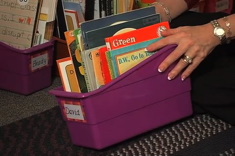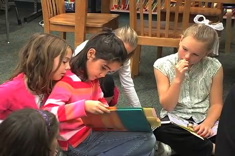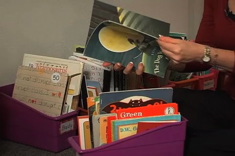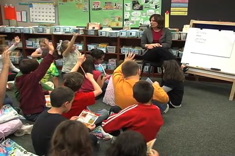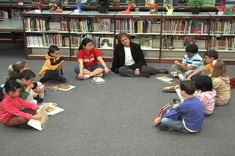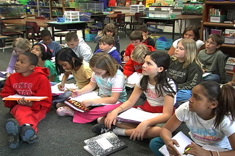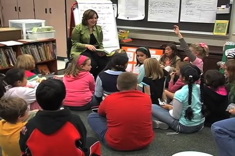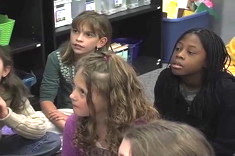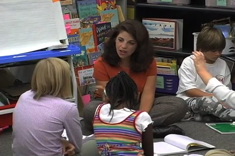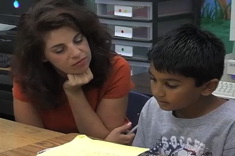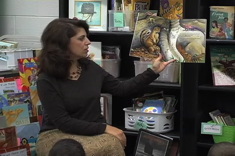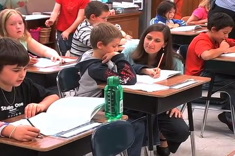4th
Latest Content
Writing Comics: Introducing the Activity
In this lesson from a fourth-grade classroom, Sarah Thibault introduces students to a writing activity. Students will be creating their own comic books, after extensive preparation and experience with mentor texts.
4th Grade Room Tour
In this video tour of her 4th grade classroom, Aimee Buckner highlights how she arranges books, charts, and other resources to support the reading and writing of her students.
Learning from Graphica: Conferring with Students
In this lesson series from a 4th grade classroom, Sarah Thibault introduces students to a writing activity. Students will be creating their own comic books, after extensive preparation and experience with graphica. In this installment, Sarah confers with students during writer's workshop as they brainstorm character traits. Students will be creating their own comic books, after extensive preparation and multiple reading and writing activities.
4th Grade Small Group: Writing Paragraphs
In this video, Aimee Buckner uses a mentor text to demonstrate how writers construct lively nonfiction paragraphs.
Learning from Graphica: Class Discussion
This is the third installment of a video series on using graphica in a 4th grade classroom. In this episode, Sarah Thibault debriefs with her class after writing workshop. Students are creating their own comic books, after extensive preparation and multiple reading and writing activities.
4th Grade Small-Group Lesson: Dialogue
One of the challenges of working with intermediate writers is helping them understand how and when to use dialogue in their writing. In this video of a small-group lesson, Aimee Buckner uses a mentor text and a metaphor to help her 4th grade students understand the value of using dialogue sparingly in their writing.
Helping Young Readers Become Independent: The “Next-Read” Stack and Peer Groups
Franki Sibberson explains how "next-read" stack conferences work in her grades 3-4 classroom.
Old Elm Speaks: Connecting Poetry, Observation, and Reading
In this first installment of a three-part video series, Aimee Buckner shows how observation skills, poetry, and reading instruction come together with the mentor text Old Elm Speaks by Kristin O’Connell George.
Helping Students Set Nonfiction Reading Goals
Franki Sibberson finds nonfiction reading goals elevate the value of nonfiction in her grades 3-4 classroom.
Old Elm Speaks Day 2: Connecting Poetry, Observation, and Reading
In this second installment of a three-part video series, Aimee Buckner shows how observation skills, poetry, and reading instruction come together with the mentor text Old Elm Speaks by Kristin O'Connell George.
Book Choice and Planning Lesson
Franki Sibberson teaches her students about book choice in this video from her grades 3-4 classroom.
Sports Writing Group Discussion
Franki Sibberson finds sports writing is a powerful motivator for boys in her grades 3-4 classroom.
Managing Book Boxes
In this first video in our “Organizing Book Boxes” series, Joan Moser (of “The Sisters”) explains three strategies she uses to help students pick books for their book boxes.
Talking About Tests
Franki Sibberson prepares her grades 3-4 students for state examinations by helping them observe attributes and patterns in test questions.
Differentiating Book Boxes
In this second video in our "Organizing Book Boxes" series, Joan Moser (of "The Sisters") explains how she differentiates the content of book boxes for students with different skills and needs.
Nonfiction Word Hunt Part I
Word study and nonfiction reading are combined in Franki Sibberson's nonfiction word hunt activity.
Book Boxes Nuts and Bolts
In this third video in our "Organizing Book Boxes" series, Joan Moser (of "The Sisters") tackles the issue of what types of books and what levels are appropriate for student book boxes.
Nonfiction Word Hunt Part II
Franki Sibberson explains the value of the nonfiction word hunt activity.
Tiger Teams: Mixed Age Student Groups
In this video, Karen Szymusiak (the principal at Glacier Ridge Elementary School in Dublin, Ohio) explains how “Tiger Teams” work. Tiger Teams are mixed age groups of K-5 students who meet regularly to talk about their learning and the school community.
Test-Taking Skills: Reading Strategies for Word Problems Part I
Question It – Know It – Show It are the keys to test preparation in Andrea Smith's 4th grade classroom.
Crafting Characters in Writer’s Workshop
If you are looking for a “peppery” heroine, Mary from The Secret Garden is one for the ages. In this video of a lesson in writer’s workshop, Franki Sibberson shows how shared text can be used to help young writers understand character traits and development.
Collaborative Team Meeting: Assessing and Planning Together
Gail Boushey leads a collaborative planning meeting between 4th grade teachers, literacy coaches, and the principal early in the year.
Rule of 3: Writer’s Craft Whole-Class Lesson
Aimee Buckner teaches her fourth-grade students about the “Rule of 3” in writing.
Rule of 3: Mini-Group After Whole-Class Lesson
In this second video of a three-part series showing a teaching progression for the Rule of 3, Aimee Buckner has asked students who might want a little more information or help after the whole-class lesson to stay for a small group.
Rule of 3: Conferring
In this final video of a three-part series showing a teaching progression for “Rule of 3,” Aimee Buckner confers with individual students during writing workshop, checking in to see how they are applying the concept to their writing.
Listing Strategy: Minilesson
Aimee Buckner presents a listing strategy minilesson in writing workshop.
Book Matchmaker: Texts for “Outdoorsy” Boys
Those “outdoorsy” boys who love to fish and four-wheel all summer long can be a challenge to hook with books when they return to classrooms in the fall. This Book Matchmaker feature presents a video preview of new titles to entice these intermediate readers, as well as a print supplement of additional suggestions.
Word Choice Lesson: A Collaborative Coaching Session with a New Teacher
Jennifer Allen collaborates with a new teacher, Jessica, early in the fall to teach a lesson in Jessica’s 4th grade classroom.
Fonts Lesson: A Revision Strategy for Transitional Writers
Franki Sibberson teaches a minilesson on fonts as a revision strategy for her grades 3 and 4 students.
Fonts: Small Group and Conferring with Intermediate Writers
In this follow-up to a whole class lesson and discussion of fonts, Franki Sibberson pulls together a group of 3rd and 4th graders from her class who have asked to be a part of a small group on fonts.
Browse Content By
Type
Category
- Assessment Tools
- Big Fresh Archives
- Booklists
- Choice Numeracy
- Classroom Design
- Common Core
- Community Building
- Conferring
- Content Literacy
- Digital Literacy
- English Language Learners
- Equity
- Family Relations
- Free Samples
- Guiding Groups
- Leadership
- Literacy Coaches
- Mentor Texts
- Minilessons
- New Teacher Mentors
- Podcasts
- Poetry
- Quote Collections
- Reading Strategies
- Self Care
- Struggling and Striving Learners
- Talking and Listening
- Teacher Study Groups
- Teaching Reading
- Teaching Writing
- Word Study and Vocabulary
Author
- Melissa Quimby
- Nawal Qarooni
- Gwen Blumberg
- Julie Cox
- The Lead Learners
- Hannah Tills
- Josie Stewart
- Ruth Metcalfe
- Mallory Messenger
- Becca Burk
- Jodie Bailey
- Vivian Chen
- Mary Brower
- Tiffany Abbott Fuller
- Stephanie Affinito
- Ruth Ayres
- Leigh Anne Eck
- Heather Fisher
- Shari Frost
- Julie Johnson
- Suzy Kaback
- Gigi McAllister
- Shirl McPhillips
- Melanie Meehan
- Cathy Mere
- Debbie Miller
- Tara Barnett and Kate Mills
- Tammy Mulligan
- Dana Murphy
- Bitsy Parks
- David Pittman
- Brenda Power
- Heather Rader
- Matt Renwick
- Mandy Robek
- Christy Rush-Levine
- Gretchen Schroeder
- Jen Schwanke
- Brian Sepe
- Katherine Sokolowski
- Stella Villalba
- Jennifer Vincent
Grade Level
Choice Literacy Membership
Articles
Get full access to all Choice Literacy article content
Videos
Get full access to all Choice Literacy video content
Courses
Access Choice Literacy course curriculum and training

